Sliced pepperoni is a popular pizza topping that can add flavor to meals without adding too many calories or carbs. Whether you enjoy it on a pizza, in a sandwich, or as a snack, understanding the nutritional content of sliced pepperoni is important for making informed dietary choices.
Pepperoni nutrition facts reveal that while it is a tasty and versatile ingredient, it is essential to consume it in moderation due to its fat and sodium content. By being mindful of portion sizes and exploring healthier options, you can still enjoy the flavors of pepperoni while making healthier choices for your overall well-being.
Key Takeaways:
- Sliced pepperoni is a popular pizza topping with a distinct flavor.
- It can add taste to meals without adding excessive calories or carbs.
- Hormel turkey pepperoni is a widely consumed product with 5 grams of protein per serving.
- Pepperoni pizza contains an average of 298 calories, 12 grams of fat, 33 grams of carbohydrates, and 13 grams of protein per slice.
- Sliced pepperoni has less fat and calories compared to thick-sliced pepperoni.
- Pairing sliced pepperoni with vegetables can increase the nutrient and fiber content of your meal.
- Portion control is crucial when consuming sliced pepperoni.
- Pepperoni is high in saturated fat and sodium, so it is important to balance consumption with other protein sources.
- Processed meats like pepperoni have been linked to an increased risk of certain cancers.
- Consider healthier alternatives such as low-fat or turkey pepperoni options.
What is the Nutritional Information for Pepperoni?
Let’s take a closer look at the nutritional information for sliced pepperoni and understand how it can impact our diet. Sliced pepperoni is a popular choice for pizza toppings and sandwich fillings, but it’s important to be aware of its nutritional content. Each slice of pepperoni typically contains around 25-30 calories, depending on the brand and thickness of the slices. A serving size is usually about 15 slices, which adds up to approximately 375-450 calories.
Pepperoni is a good source of protein, with about 6-7 grams per serving. Protein is essential for muscle growth, repair, and overall health. It also helps to keep you feeling full and satisfied. However, it’s important to note that pepperoni is high in fat, especially saturated fat. A serving of pepperoni can contain around 4-5 grams of fat, with a significant portion of that being saturated fat.
If you’re watching your sodium intake, it’s worth noting that pepperoni is relatively high in sodium. A single serving can provide around 500-600 milligrams of sodium, which can contribute to high blood pressure and other health issues if consumed in excess. It’s important to be mindful of your sodium intake and consider other lower-sodium options if necessary.
The Nutritional Information for Sliced Pepperoni
| Nutrient | Amount per Serving |
|---|---|
| Calories | 25-30 |
| Protein | 6-7 grams |
| Total Fat | 4-5 grams |
| Saturated Fat | 1-2 grams |
| Sodium | 500-600 milligrams |
| Carbohydrates | 0 grams |
While sliced pepperoni can add flavor to your meals, it’s important to consume it in moderation and consider healthier alternatives. Opting for turkey pepperoni or low-fat options can help reduce the fat content while still providing that delicious pepperoni flavor. Additionally, using sliced pepperoni as a topping rather than the main ingredient can help control portion sizes and reduce the overall calorie intake. Pairing sliced pepperoni with plenty of vegetables can also add nutrients and fiber to your dish, creating a more balanced and nutritious meal.
Remember, it’s all about finding a balance and making informed choices that align with your dietary needs and goals. By being aware of the nutritional information of sliced pepperoni, you can enjoy it as part of a varied and well-rounded diet while still maintaining a healthy lifestyle.
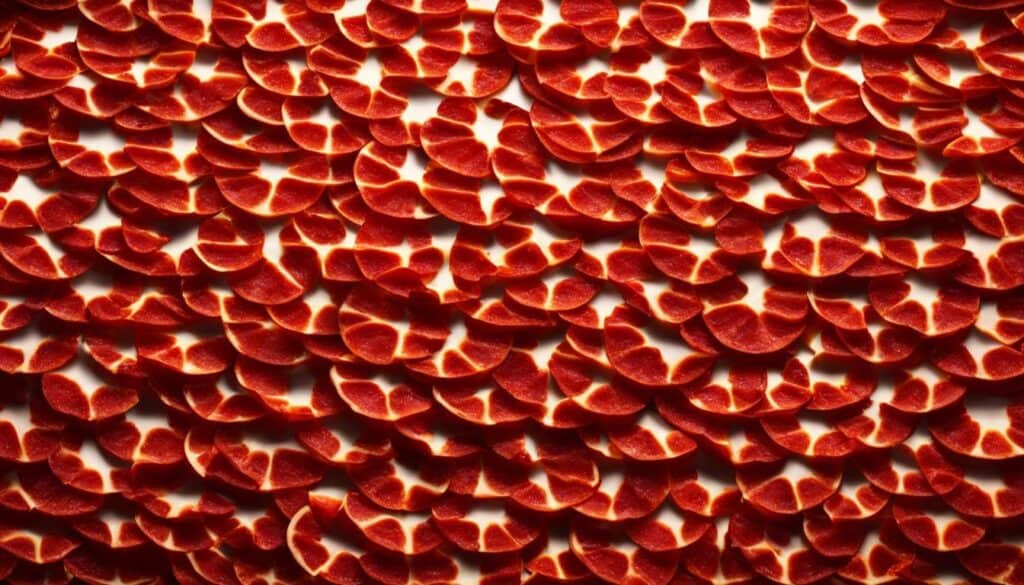
Wondering how many calories are in your favorite slice of pepperoni pizza? Let’s find out! Sliced pepperoni is a delicious and popular topping that adds a burst of flavor to any pizza. However, it’s important to be mindful of its calorie content if you’re watching your intake. One slice of pepperoni pizza contains around 298 calories on average. This calorie count can vary depending on the size and thickness of the slice, as well as the specific brand or recipe used.
To put it into perspective, one slice of pepperoni pizza typically contains about 12 grams of fat, 33 grams of carbohydrates, and 13 grams of protein. While it does provide a decent amount of protein, it’s also important to note that it contains a relatively high amount of fat. So, if you’re trying to maintain a balanced diet or reduce your calorie intake, it’s a good idea to be mindful of your portion sizes and pair your slice of pizza with healthier options.
Pairing Sliced Pepperoni with Vegetables for a Balanced Meal
To make your pepperoni pizza more nutritious and well-rounded, consider adding vegetables as toppings. Vegetables like bell peppers, onions, mushrooms, and tomatoes are not only low in calories but also provide essential vitamins, minerals, and fiber. They can help balance out the calorie content of the pizza and add more nutrients to your meal.
For example, you can load your pizza with a variety of colorful veggies and combine them with a moderate amount of sliced pepperoni. This way, you’ll still enjoy the flavor of the pepperoni but also benefit from the added nutrients and fiber from the vegetables. It’s a win-win situation!
In summary, sliced pepperoni pizza can be a delicious treat, but it’s important to be mindful of its calorie content. Remember to practice portion control, balance your intake with other sources of protein, and consider adding nutrient-rich vegetables to your pizza for a more balanced and nutritious meal.
| Nutrient | Amount per Slice |
|---|---|
| Calories | Approximately 298 |
| Fat | Approximately 12 grams |
| Carbohydrates | Approximately 33 grams |
| Protein | Approximately 13 grams |
The Comparison: Sliced Pepperoni vs. Thick-Sliced Pepperoni
Is there a significant difference in calorie content between sliced pepperoni and its thick-sliced counterpart? Let’s compare them.
When it comes to nutritional value, sliced pepperoni generally has less fat and calories compared to thick-sliced pepperoni. This makes it a preferable choice for those looking to enjoy the deliciousness of pepperoni while keeping their calorie intake in check. Sliced pepperoni is also lower in sodium, making it a healthier option for individuals concerned about their sodium intake. Plus, it can be a great way to add flavor to your dishes without jeopardizing your diet goals.
Pairing sliced pepperoni with vegetables is a smart way to create a balanced meal. Vegetables can add essential nutrients and fiber to your dish, while the sliced pepperoni provides the taste and protein. By combining these ingredients, you can enjoy a satisfying and nutritious meal.
Table 1: Nutritional Comparison of Sliced Pepperoni and Thick-Sliced Pepperoni
| Ingredient | Calories | Fat | Sodium |
|---|---|---|---|
| Sliced Pepperoni (per serving) | 60 | 5g | 300mg |
| Thick-Sliced Pepperoni (per serving) | 90 | 8g | 400mg |
As you can see from the table above, sliced pepperoni has significantly fewer calories, less fat, and lower sodium content compared to its thick-sliced counterpart. It’s a clear choice for those aiming for a healthier option without compromising on taste.
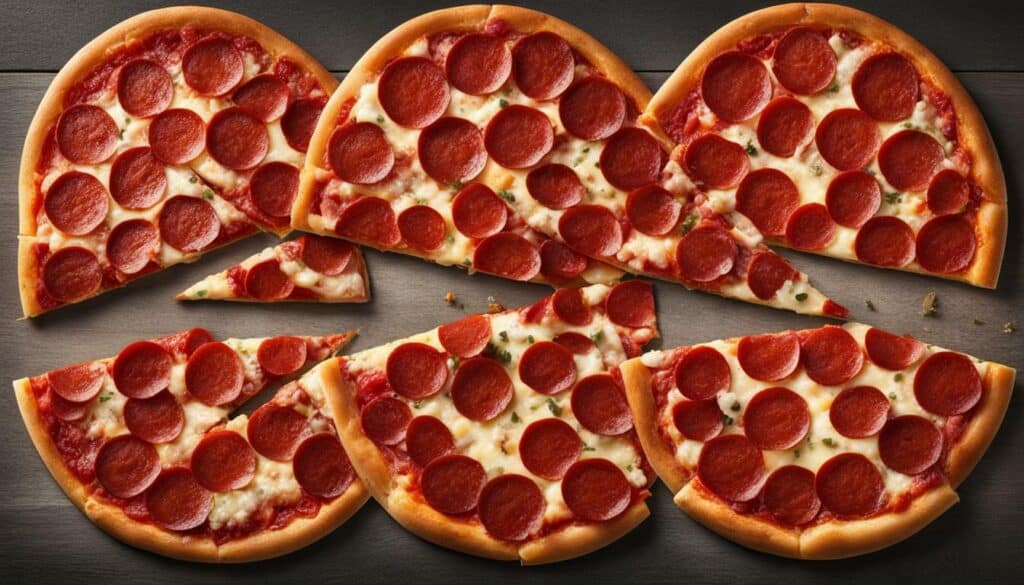
Remember, while pepperoni does offer some benefits like high protein content and iron, it is important to practice portion control and consider other sources of protein in your diet. Processed meats like pepperoni have been associated with an increased risk of certain cancers, and they are high in saturated fat and sodium. Making mindful choices, such as opting for low-fat or turkey pepperoni options, and using pepperoni as a topping rather than the main ingredient, can help you enjoy the taste while prioritizing your health.
To summarize, sliced pepperoni is a lower-calorie, lower-fat, and lower-sodium option compared to thick-sliced pepperoni. By combining it with vegetables and practicing portion control, you can create a balanced and flavorful meal. So go ahead and indulge in the goodness of sliced pepperoni while keeping your health goals in mind!
Pairing Sliced Pepperoni with Vegetables for a Balanced Meal
Looking for a way to enjoy sliced pepperoni while maintaining a balanced diet? Consider pairing it with vegetables for a wholesome meal. Sliced pepperoni can provide a flavorful addition to your dishes, and when combined with nutrient-rich veggies, it becomes a satisfying and nutritious option.
One way to incorporate sliced pepperoni into a balanced meal is by creating a colorful and vibrant salad. Start with a bed of fresh mixed greens, topped with cherry tomatoes, sliced cucumbers, and bell peppers. Add a handful of sliced pepperoni for a savory touch. You can also enhance the flavor by incorporating olives and feta cheese. Drizzle your favorite dressing over the salad and toss it all together for a delicious and satisfying meal.
Another option is to use sliced pepperoni as a topping for roasted vegetables. Chop up a variety of vegetables such as zucchini, eggplant, and bell peppers, and spread them on a baking sheet. Season with herbs and spices, then add a layer of sliced pepperoni on top. Roast in the oven until the vegetables are tender and the pepperoni is crispy. This dish is not only tasty but also packed with fiber, vitamins, and minerals.
A Sample Recipe: Pepperoni-Stuffed Zucchini Boats
- Preheat the oven to 375°F (190°C).
- Cut zucchinis in half lengthwise and scoop out the inner flesh to create “boats”.
- Chop the scooped-out zucchini flesh and mix it with diced tomatoes, shredded mozzarella cheese, and sliced pepperoni.
- Season the mixture with Italian herbs, garlic powder, salt, and pepper.
- Spoon the mixture into the zucchini boats, then place them on a baking sheet.
- Bake in the preheated oven for 20-25 minutes or until the zucchini is tender and the cheese is melted and golden.
- Serve the pepperoni-stuffed zucchini boats as a main dish or a side.
Remember, moderation is key when enjoying sliced pepperoni. While it adds flavor and protein to your meals, it’s important to balance it with other protein sources and be mindful of portion sizes. By incorporating sliced pepperoni into a nutritious meal alongside vegetables, you can create a satisfying and well-rounded dining experience.
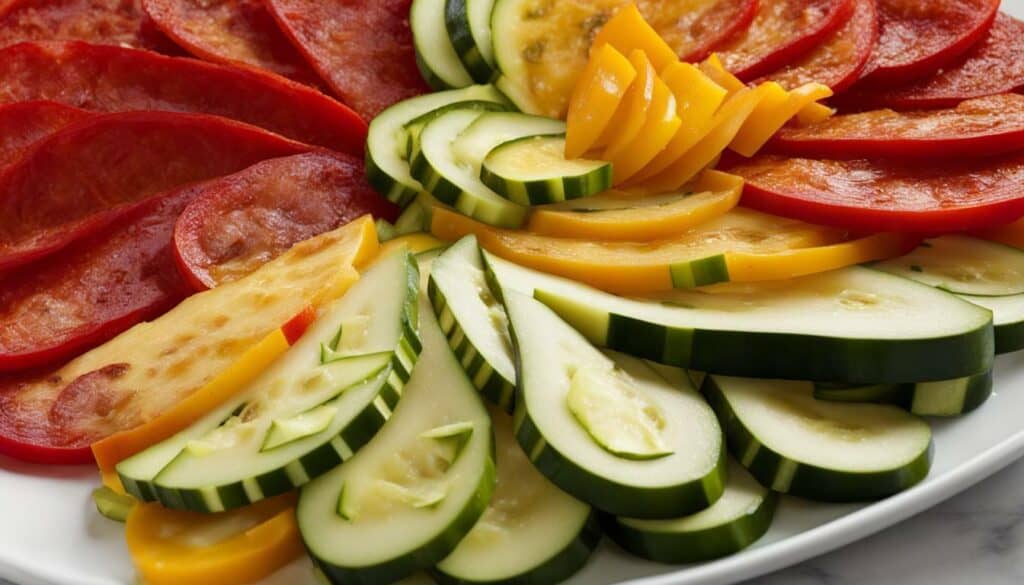
| Pepperoni Nutrition Facts (1 serving – 17 slices) | Amount per serving |
|---|---|
| Calories | 140 |
| Total Fat | 12g |
| Saturated Fat | 5g |
| Cholesterol | 30mg |
| Sodium | 680mg |
| Protein | 7g |
The Importance of Portion Control and Considering Other Protein Sources
While sliced pepperoni provides protein and iron, it’s crucial to practice portion control and diversify protein sources in our diet. Although it can be tempting to pile on the pepperoni when enjoying a slice of pizza or adding it to sandwiches and salads, it’s important to remember that moderation is key. Sliced pepperoni may contain fewer calories and less fat compared to thicker slices, but it’s still important to be mindful of how much we consume.
One way to practice portion control is by using sliced pepperoni as a topping rather than the main ingredient of a dish. By sprinkling a few slices onto a salad or adding it as a garnish to a pizza, we can still enjoy the flavor without going overboard. This allows us to incorporate the taste of pepperoni into our meals while also making room for other protein sources, such as lean meats, fish, tofu, or legumes.
When it comes to protein, variety is key. While sliced pepperoni does provide protein, incorporating a range of protein sources into our diet ensures we receive a wide array of essential amino acids and nutrients. This helps to support overall health and well-being. So, in addition to enjoying sliced pepperoni, consider including other lean protein options like chicken breast, salmon, lentils, or Greek yogurt in your meals to diversify your protein intake.
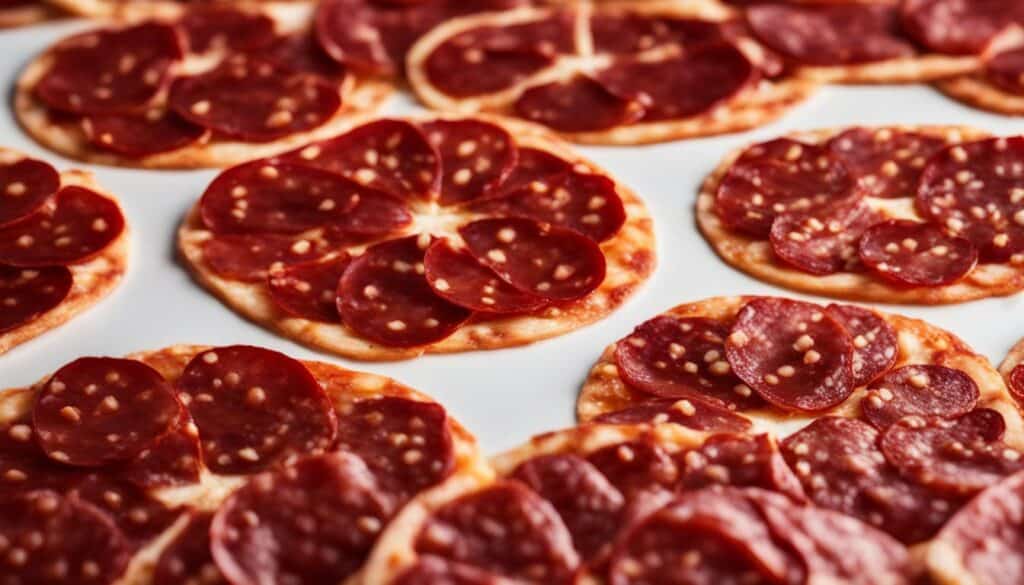
| Nutrient | Sliced Pepperoni (1 oz) |
|---|---|
| Calories | 138 |
| Total Fat (g) | 12 |
| Protein (g) | 6 |
| Sodium (mg) | 420 |
By being conscious of portion sizes and incorporating a variety of protein sources into our diet, we can enjoy the flavor of sliced pepperoni while ensuring a balanced and nutritious meal. Remember, balance is key, and by making informed choices, we can continue to savor the taste of sliced pepperoni as part of a healthy lifestyle.
Drawbacks of Consuming Pepperoni: High in Saturated Fat and Sodium
It’s essential to be aware of the potential drawbacks of consuming pepperoni due to its high saturated fat and sodium levels. While pepperoni can be a tasty addition to pizzas and other dishes, it is important to consume it in moderation and understand its nutritional impact on our health.
One of the main concerns with pepperoni is its high saturated fat content. Saturated fats have been linked to an increased risk of heart disease and high cholesterol levels. A serving of pepperoni can contribute a significant amount of saturated fat to your diet, which can negatively affect your cardiovascular health over time.
Another drawback of pepperoni is its high sodium content. Processed meats like pepperoni are known to be high in sodium, which can contribute to high blood pressure and increase the risk of heart disease. Excessive sodium intake is a common issue in today’s diet, and reducing our consumption of processed meats can help in managing sodium levels.
While pepperoni does offer some benefits such as high protein content and iron, it is important to be mindful of these drawbacks. It is recommended to make healthier choices when possible, such as opting for low-fat or turkey pepperoni options. Additionally, using pepperoni as a topping rather than the main ingredient can help reduce your overall intake of calories, fat, and sodium.
| Nutrient | Amount per Serving |
|---|---|
| Calories | 98 |
| Total Fat | 8g |
| Saturated Fat | 3g |
| Sodium | 552mg |
| Protein | 6g |
Healthier Choices: Low-Fat and Turkey Pepperoni Options
Are there healthier alternatives to traditional pepperoni? Let’s explore low-fat and turkey pepperoni options for a more nutritious choice. While pepperoni is a popular pizza topping, it is important to be mindful of its high fat and sodium content. Fortunately, there are alternatives available that can provide a lower-calorie option without sacrificing taste.
“Low-fat and turkey pepperoni can be great alternatives for those looking to reduce their calorie and fat intake while still enjoying the delicious flavor of pepperoni.”
Low-fat pepperoni is made with leaner cuts of meat and contains significantly less fat than traditional pepperoni. It is also lower in calories and sodium, making it a healthier choice for those watching their intake of these nutrients. Additionally, turkey pepperoni is another alternative that offers a leaner option. It is typically made with turkey meat and contains less fat and calories compared to traditional pork-based pepperoni.
To give you an idea of the nutritional differences, let’s compare low-fat pepperoni and turkey pepperoni to the traditional variety. On average, a serving of low-fat pepperoni contains around 45 calories and 3 grams of fat, while turkey pepperoni contains about the same. In contrast, traditional pepperoni can have over 100 calories and 9 grams of fat per serving.
| Pepperoni Type | Calories per Serving | Total Fat per Serving |
|---|---|---|
| Traditional Pepperoni | 100+ | 9+ |
| Low-Fat Pepperoni | 45 | 3 |
| Turkey Pepperoni | 45 | 3 |
When it comes to taste, low-fat and turkey pepperoni options can still deliver the savory and slightly spicy flavor that pepperoni is known for. They can be used as a topping for pizzas, added to salads, or incorporated into wraps and sandwiches. It is worth noting that the texture and taste may vary slightly compared to traditional pepperoni, but the reduced fat content and nutritional benefits make these alternatives worth considering.
By choosing low-fat or turkey pepperoni options, you can still enjoy the taste of pepperoni while making a healthier choice for your overall well-being. Incorporating these alternatives into your meals allows you to satisfy your cravings while reducing your intake of fat and calories. Remember, moderation is key, and it is always a good idea to consult with a healthcare professional or nutritionist for personalized dietary advice.
Summary:
- Low-fat and turkey pepperoni options provide healthier alternatives to traditional pepperoni.
- They are lower in calories, fat, and sodium compared to traditional pepperoni.
- Low-fat and turkey pepperoni can be used as toppings for pizzas, added to salads, or incorporated into wraps and sandwiches.
- While the taste and texture may vary slightly, the reduced fat content and nutritional benefits make these alternatives worth considering.
- Choose low-fat or turkey pepperoni options to enjoy the taste of pepperoni while making a healthier choice for your overall well-being.
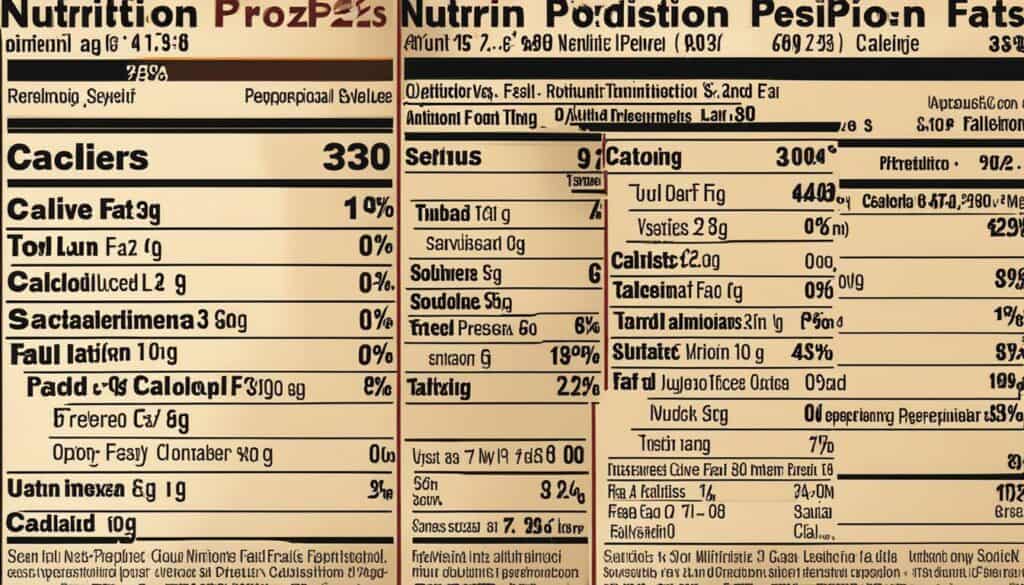
Understanding the calories in sliced pepperoni allows us to enjoy this flavorful topping while maintaining a balanced and mindful diet. Sliced pepperoni is a popular pizza topping that can add a burst of flavor to your meals without adding too many calories or carbs. It is important, however, to consume it in moderation due to its high fat content.
Hormel turkey pepperoni, which is widely consumed, offers 5 grams of protein per serving, making it a good source of this essential nutrient for building and repairing tissues in the body. However, it also contains 8 grams of fat per serving, so it is crucial to practice portion control when enjoying it.
One slice of pepperoni pizza contains around 298 calories, 12 grams of fat, 33 grams of carbohydrates, and 13 grams of protein on average. This information can help you make informed choices about your pizza toppings and plan your meals accordingly.
Compared to thick-sliced pepperoni, sliced pepperoni has lower fat and calorie content. It is also lower in sodium, making it a better choice for those watching their sodium intake. Pairing sliced pepperoni with vegetables is a great way to add nutrients and fiber to your dish, creating a more balanced meal.
It is important to remember that while pepperoni does offer some benefits, such as high protein content and iron, it is high in saturated fat and sodium. Processed meats like pepperoni have also been linked to an increased risk of certain cancers. Therefore, it is essential to be mindful of these drawbacks and make healthier choices when possible. Opting for low-fat or turkey pepperoni options and using pepperoni as a topping rather than the main ingredient can help reduce your intake of saturated fat and sodium.
By understanding the calorie content and nutritional information of sliced pepperoni, you can enjoy this delicious topping in a way that aligns with your health goals. Whether you choose to indulge in a slice of pepperoni pizza or use it as a flavorful addition to your meals, moderation and balance are key to maintaining a healthy lifestyle.
FAQ
Q: What is the nutritional information for sliced pepperoni?
A: Sliced pepperoni contains 8 grams of fat, 5 grams of protein, and no carbohydrates per serving. It is important to note that the nutritional information may vary depending on the brand and type of pepperoni.
Q: How many calories are in sliced pepperoni pizza?
A: One slice of pepperoni pizza contains around 298 calories, 12 grams of fat, 33 grams of carbohydrates, and 13 grams of protein on average. The calorie count may vary depending on the size and thickness of the slice.
Q: What are the differences between sliced pepperoni and thick-sliced pepperoni?
A: Sliced pepperoni generally has fewer calories and fat compared to thick-sliced pepperoni. It is also lower in sodium. However, the exact nutritional differences may vary depending on the brand and type of pepperoni.
Q: How can I incorporate sliced pepperoni into a balanced meal?
A: Sliced pepperoni can be paired with vegetables to add nutrients and fiber to your dish. You can use it as a topping for salads, wraps, or omelets, or mix it with roasted vegetables for a flavorful side dish.
Q: Is portion control important when consuming sliced pepperoni?
A: Yes, portion control is crucial when consuming sliced pepperoni. It is high in fat and calories, so it should be enjoyed in moderation. Consider using it as a topping rather than the main ingredient and balance your pepperoni consumption with other sources of protein.
Q: What are the drawbacks of consuming pepperoni?
A: Pepperoni is high in saturated fat and sodium, which can have negative effects on your health. It has also been linked to an increased risk of certain cancers. It is important to be mindful of these drawbacks and make healthier choices when possible.
Q: Are there healthier choices for pepperoni?
A: Yes, there are healthier options for pepperoni available. You can opt for low-fat or turkey pepperoni, which have reduced fat content. Be sure to check the nutritional information and choose options that fit your dietary needs and preferences.
Q: What is the importance of considering other protein sources?
A: While pepperoni does offer some benefits such as high protein content, it is important to consider other sources of protein as well. Incorporating a variety of protein-rich foods into your diet ensures that you are getting a wide range of essential nutrients.
How Many Calories are in a S’more and is it Worth it?
When it comes to counting s’mores calories for sweet tooth cravings, it’s essential to consider the indulgence. A typical s’more contains about 215-250 calories. While it may not be the healthiest treat, the delicious combination of chocolate, marshmallow, and graham cracker is undeniably tempting. Ultimately, determining if it’s worth it depends on individual preferences and dietary goals.

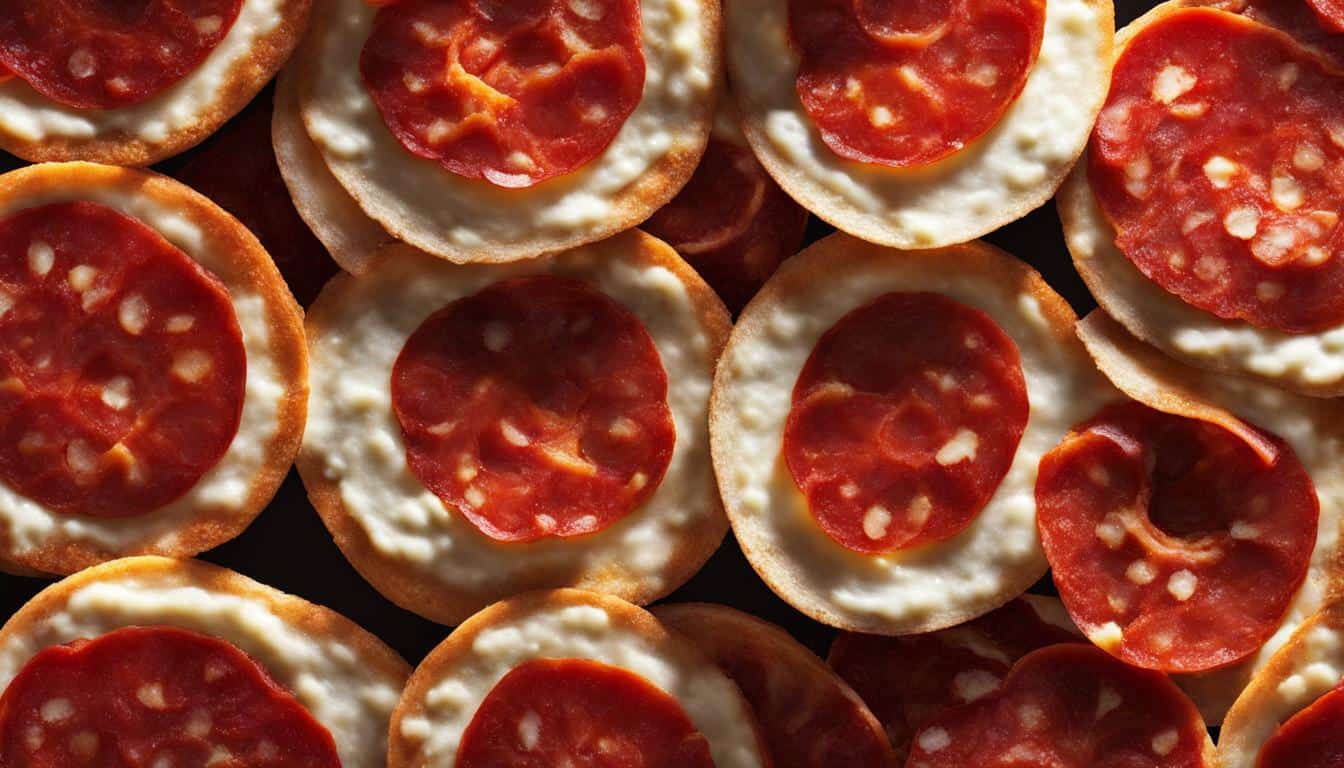
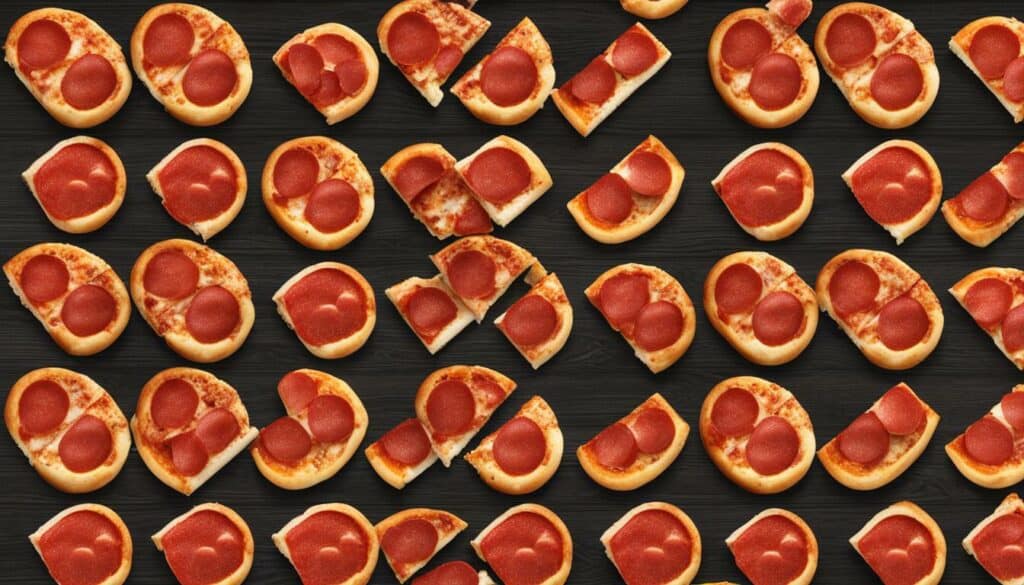



Leave a Reply